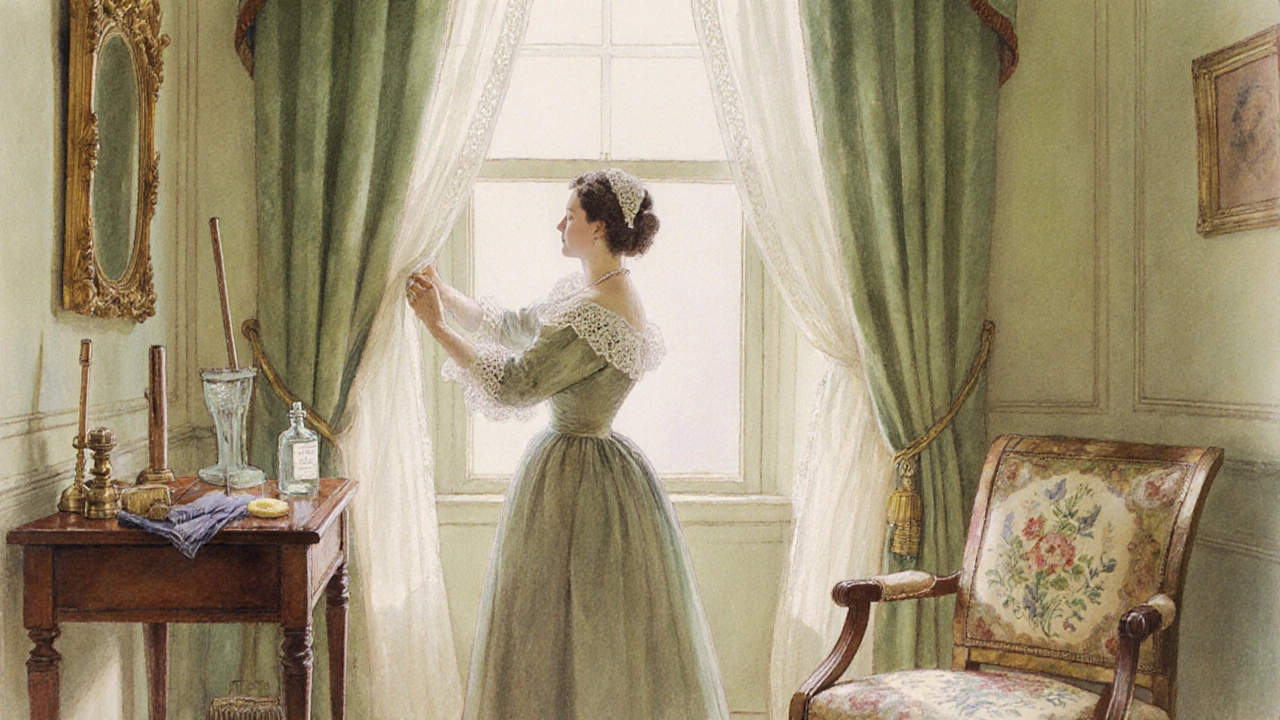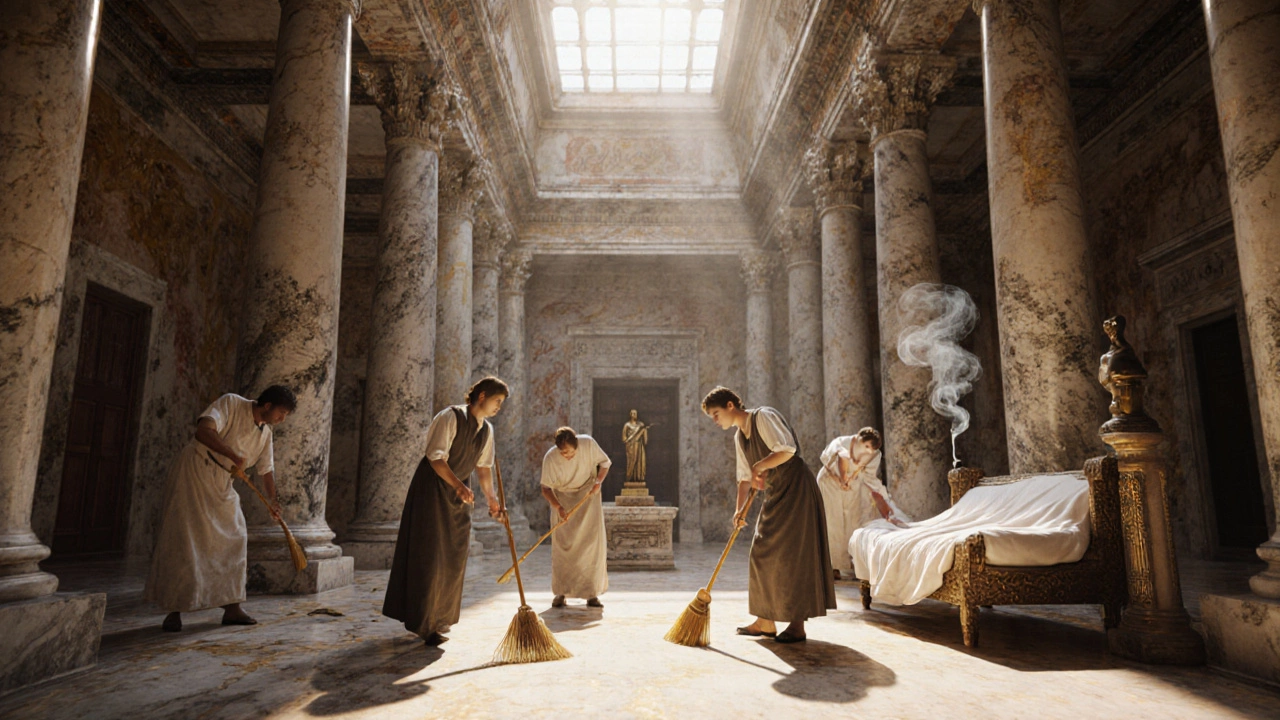Spring Cleaning Timeline Explorer
Discover the Origins of Spring Cleaning
Explore how spring cleaning evolved from ancient rituals to modern practices across different cultures.
On March 1st, Romans swept their homes, replaced bedding, and honored the goddess Juno. This marked the beginning of the new consular year.
Families perform "kashering," removing chametz (leavened products) and thoroughly cleaning their homes to symbolize spiritual renewal.
Known as "khaneh tekani," this tradition involves sweeping, beating carpets, and discarding old items to welcome new beginnings.
Cleaning after Lenten fasts aligned with Christian holidays, emphasizing renewal and preparation for Easter.
Cleanliness became linked with moral virtue; deep cleaning was seen as cleansing the soul, especially in Britain.
Household management guides emphasized spring cleaning for airing rooms, washing curtains, and polishing furniture.
Scientific understanding of microbes led to health-focused spring cleaning to combat allergies and respiratory issues.
Mass-produced cleaning products and media campaigns made spring cleaning a consumer-driven ritual with commercial branding.
Today's spring cleaning focuses on eco-friendly practices, health improvements, and sustainable habits.
Did You Know?
The phrase "spring cleaning" first appeared in English in the early 1800s. It was popularized by Victorian household guides urging families to clean their homes in spring for health and beauty reasons.
Compare Cultural Practices
| Culture | Timing | Main Activities | Meaning |
|---|---|---|---|
| Ancient Rome | March 1st | Sweeping, replacing bedding | Honor Juno, welcome new year |
| Jewish (Passover) | Early Spring (Nisan) | Kashering, deep dusting | Spiritual purification |
| Persian (Nowruz) | Spring equinox | Khaneh tekani | New beginnings |
| Victorian England | Post-Easter | Washing curtains, polishing furniture | Domestic order |
| Modern Western | Late March – April | Vacuuming, decluttering, eco-swap | Health, environmental awareness |
When we talk about spring cleaning is a seasonal deep‑cleaning ritual that many households observe each year, most people picture dusting shelves, washing windows, and decluttering closets. But how did this habit get its name, and why does it line up with the arrival of warmer weather? The answer stretches back millennia, weaving through ancient empires, religious festivals, and the rise of modern hygiene.
Ancient Roots: From Rome to the Middle East
In Ancient Rome, the calendar marked a specific day-March 1st-as the start of the cleaning season. Wealthy Romans would sweep out their homes, clear out accumulated grime, and even replace bedding before the new consular year began. The practice was tied to both practical concerns (dust after winter) and religious rites that honored the goddessJuno, protector of the home.
The tradition wasn’t limited to the Mediterranean. During Jewish Passovera week‑long spring festival that commemorates the Exodus, families engage in a thorough house cleaning known as “kashering.” The goal is to remove any chametz (leavened products) that might be hidden in the home, symbolising spiritual renewal as well as physical cleanliness.
Further east, the Persian celebration of Nowruzthe Iranian New Year marking the spring equinox includes a ritual called "khaneh tekani"-literally “shaking the house.” Homes are scrubbed, carpets are beaten, and old items are discarded, making way for fresh beginnings.
Medieval and Early Modern Europe: The Puritan Influence
As Christianity spread across Europe, the timing of spring cleaning shifted toward Christian holidays. In medieval England, households often performed a deep clean after the Lenten fast, using the period before Easter as a chance to clear out stale supplies and renew the living space.
By the 18thcentury, Puritan thought linked cleanliness with moral virtue. Sermons urged congregants to “cleanse the house as one cleanses the soul,” turning seasonal cleaning into a sign of piety. This moral framing helped embed the practice into the cultural calendar, especially in the British Isles where the weather began to cooperate with the cleaning schedule.
Victorian Era and the Rise of Domestic Science
The Victorian eraa period of rapid industrialization and middle‑class growth in the 19thcentury saw the birth of modern household management guides. Authors like Mrs.Beeton published detailed instructions on when and how to deep‑clean rooms, emphasizing the arrival of spring as the perfect moment to open windows, wash curtains, and polish furniture.
Industrial advances introduced new cleaning tools-metal brooms, scented soaps, and later, electric vacuum cleaners-making the task less labor‑intensive. The combination of better tools and a growing middle class with leisure time turned spring cleaning from a necessity into a ritual of pride.

The Hygiene Movement of the Early 20thCentury
Scientific breakthroughs in microbiology reshaped public perception of dirt. The hygiene movementa public‑health campaign in the early 1900s that promoted sanitation to combat disease highlighted how dust mites and airborne particles could trigger allergies and respiratory problems.
Hospitals and schools began regular deep‑cleaning schedules, and the idea filtered into the home. Articles in popular women’s magazines urged readers to schedule a "spring sanitisation" to reduce germs before the allergy season. This health‑focused narrative gave spring cleaning a scientific backing that persists today.
Post‑World WarII Boom and the Consumer Age
After 1945, prosperity and mass‑produced cleaning products flooded the market. Brands like Tide and Ajax advertised spring‑time campaigns, reinforcing the link between commercial products and the seasonal ritual.
Television shows such as "The Homemaker’s Guide" featured step‑by‑step spring cleaning segments, cementing the idea that a clean home reflected good family management. By the 1960s, the phrase "spring cleaning" had become a staple in everyday conversation across the United States, the United Kingdom, and beyond.
Why Spring? The Climate Connection
From a practical standpoint, spring offers the perfect blend of warmer temperatures and lower humidity, making it easier to dry cleaned surfaces and air out rooms. Dust that settled during cold, damp winters becomes more noticeable as sunlight streams in.
Moreover, the natural rhythm of plants sprouting and animals emerging serves as a psychological cue for renewal. This seasonal cue aligns with human habits: we tend to feel motivated to declutter and refresh our surroundings when nature itself is undergoing a makeover.

Modern Take on an Old Tradition
Today, spring cleaning isn’t just about dusting dust. It’s an opportunity to improve indoor air quality, reduce allergens, and even adopt more eco‑friendly habits. Replacing old carpets with low‑VOC flooring, swapping chemical cleaners for plant‑based alternatives, and donating unwanted items to charity are all ways the age‑old ritual has adapted to contemporary values.
Below is a quick comparison of how different cultures still celebrate the practice.
| Culture | Key Timing | Main Activities | Underlying Meaning |
|---|---|---|---|
| Ancient Rome | March 1st | Sweeping, candle‑lit rooms, replacing bedding | Honor Juno, welcome new consular year |
| Jewish (Passover) | EarlySpring (Nisan) | Kashering: remove leavened foods, deep dusting | Spiritual purification, remembrance of Exodus |
| Persian (Nowruz) | Spring equinox | Khaneh tekani: sweeping, carpet beating, discarding old items | New beginnings, renewal |
| Victorian England | Post‑Easter | Washing curtains, polishing furniture, airing rooms | Showcase middle‑class propriety, domestic order |
| Modern Western | Late March-April | Vacuuming, decluttering, deep‑cleaning appliances, eco‑swap | Health, mental reset, environmental consciousness |
Practical Tips for a 21st‑Century Spring Clean
- Start with a room‑by‑room inventory. Write down what stays, what goes, and what needs fixing.
- Swap harsh chemicals for vinegar, baking soda, or a certified plant‑based cleaner. It’s gentler on indoor air and the planet.
- Use a high‑efficiency particulate air (HEPA) filter vacuum to capture dust mites and allergens.
- Open windows during low‑pollution hours (early morning or late evening) to let fresh air circulate.
- Donate usable items to local charities rather than sending them to landfill.
Frequently Asked Questions
When did the term “spring cleaning” first appear in English?
The phrase shows up in printed English around the early 1800s, linked to Victorian household guides that urged families to “clean the house in spring.”
Is spring cleaning only a Western tradition?
No. Similar seasonal deep‑cleans are found in many cultures, from the Roman March rituals to Jewish Passover kashering and Persian nowruz “khaneh tekani.”
Why is spring favored over other seasons for a thorough clean?
Warmer temperatures help drying, lower humidity reduces mold risk, and the natural renewal of spring provides a psychological cue for starting fresh.
Can spring cleaning improve health?
Yes. Removing dust, allergens, and stale air can lower asthma triggers, reduce indoor pollutants, and boost overall well‑being.
How often should I repeat a deep spring clean?
Most experts suggest an annual deep clean in spring, plus lighter maintenance cleaning every month to keep things manageable.
So, the next time you pull out the vacuum and open the windows, remember you’re taking part in a tradition that stretches from ancient Roman streets to modern eco‑friendly homes. Understanding the spring cleaning history not only satisfies curiosity-it gives the ritual a richer meaning and a clearer purpose for today’s world.
